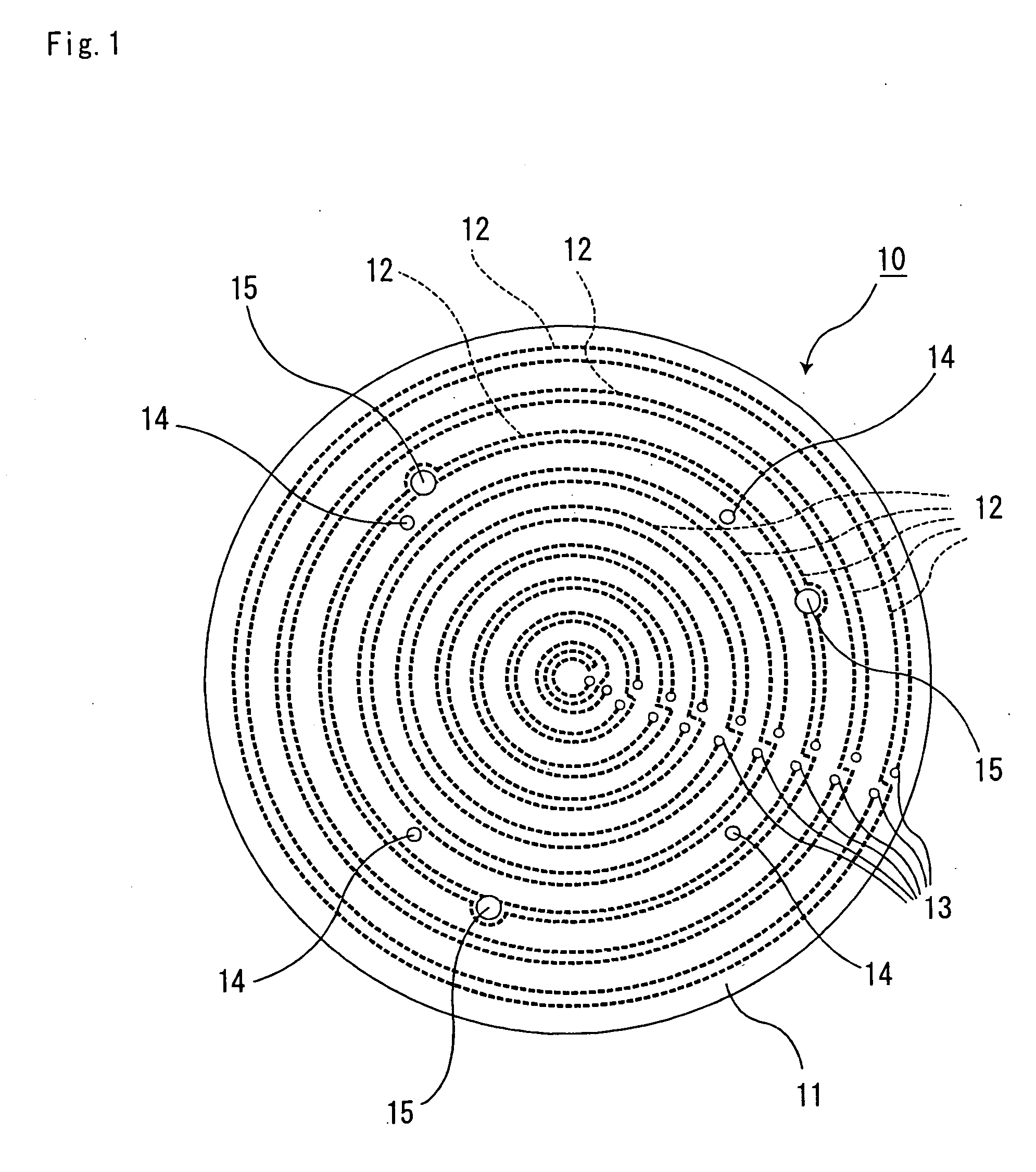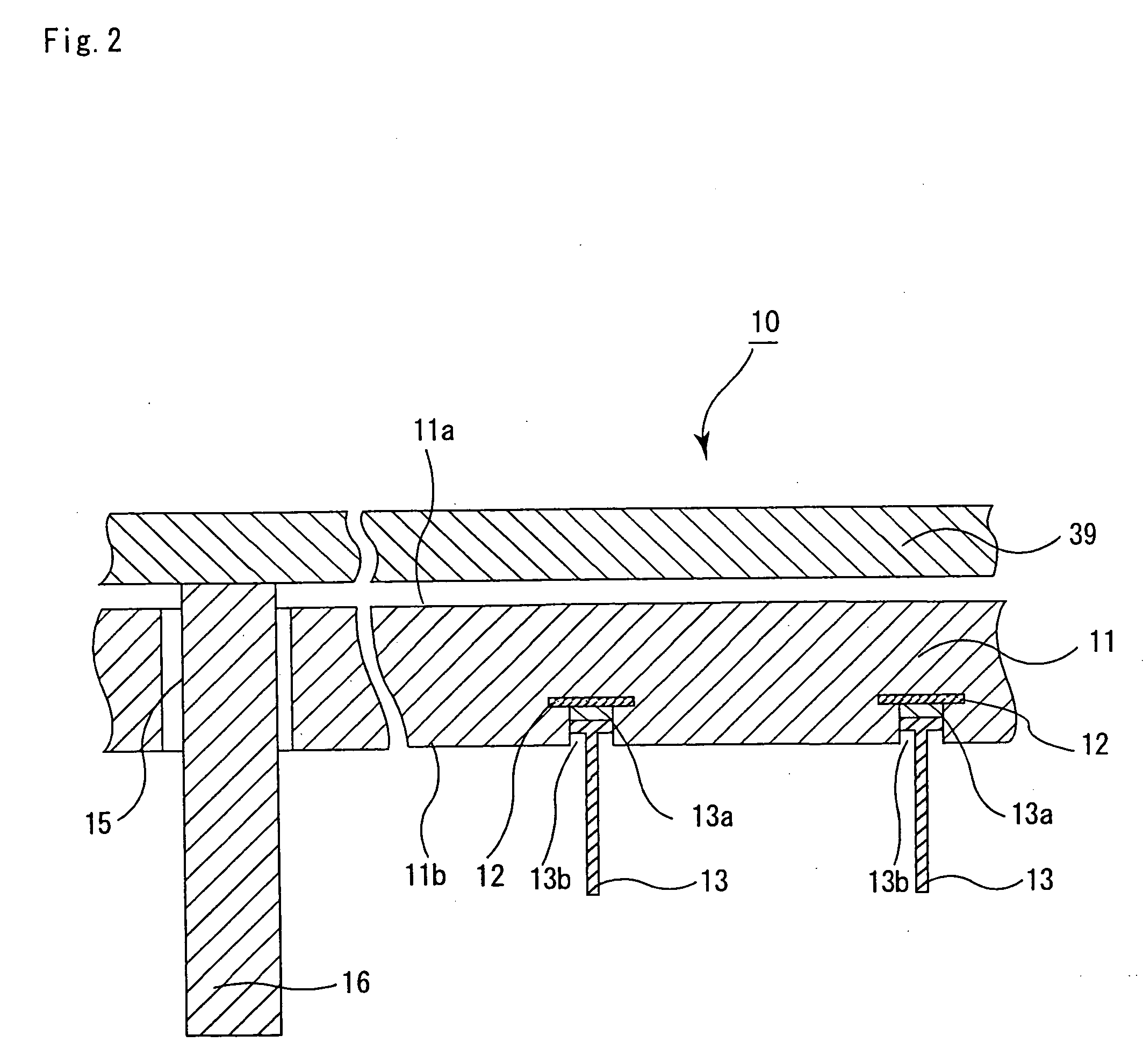Ceramic heater and ceramic joined article
a ceramic heater and heater body technology, applied in the direction of metallic material coating process, chemical vapor deposition coating, electrical equipment, etc., can solve the problems of metal heaters, difficult temperature control, heavy and bulky heaters, etc., to prevent crack generation, suppress crack generation rate, and reduce the effect of heating tim
- Summary
- Abstract
- Description
- Claims
- Application Information
AI Technical Summary
Benefits of technology
Problems solved by technology
Method used
Image
Examples
example 1
Production of Ceramic Heater (See FIGS. 1, 2 and 5)
[0405] (1) The following paste was used to perform formation by a doctor blade method, so as to form a green sheet 50 having a thickness of 0.47 μm: a paste obtained by mixing 100 parts by weight of aluminum nitride powder (manufactured by Tokuyama Corp., average particle diameter: 0.6 μm), 4 parts by weight of alumina, 11.5 parts by weight of an acrylic resin binder, 0.5 part by weight of a dispersant and 53 parts by weight of alcohols of 1-butanol and ethanol.
[0406] (2) Next, this green sheet 50 was dried at 80° C. for 5 hours, and subsequently portions which would be conductor filled through holes 13a were formed by punching.
[0407] (3) The following were mixed to prepare a conductor containing paste A: 100 parts by weight of tungsten carbide particles having an average particle diameter of 1 μm, 3.0 parts by weight of an acrylic resin binder, 3.5 parts by weight of α-terpineol solvent, and 0.3 part by weight of a dispersant.
[...
example 2
Production of Ceramic Heater (See FIGS. 3, 4 and 6)
[0419] (1) A composition made of 100 parts by weight of aluminum nitride powder (average particle diameter: 0.6 μm), 4 parts by weight of yttria (average particle diameter: 0.4 μm), 12 parts by weight of an acrylic resin binder and an alcohol was subjected to spray-drying to form granular powder.
[0420] (2) Next, this granular powder was put into a mold and formed into a flat plate form to obtain a raw formed body (green).
[0421] (3) next, this raw formed body was hot-pressed at 1800° C. and a pressure of 20 MPa to yield a nitride aluminum plate having a thickness of 3 mm.
[0422] Next, this plate was cut out into a disk having a diameter of 210 mm, so as to prepare a plate made of the ceramic (ceramic substrate 21). This ceramic substrate 21 was drilled to form three through holes 25 (diameter: 3.5 mm), for passing lifter pins 26 (diameter: 3 mm) through, and bottomed holes 24 for embedding thermocouples (see FIG. 6(a)).
[0423] The...
example 3
[0433] (1) The following paste was used to perform formation by a doctor blade method, so as to form a green sheet 50 having a thickness of 0.47 μm: a paste obtained by mixing 100 parts by weight of SiC powder (manufactured by Yakushima Denko, average particle diameter: 1.1 μm), 4 parts by weight of B4C, 11.5 parts by weight of an acrylic resin binder, 0.5 part by weight of a dispersant and 53 parts by weight of alcohols of 1-butanol and ethanol. Furthermore, 80 parts by weight of borosilicate glass having an average particle size of 1.0 μm, 5 parts by weight of polyethylene glycol and 15 parts by weight of alcohol were mixed to yield a glass paste. This glass paste was applied to the formed green sheet.
[0434] (2) Next, this green sheet was dried at 80° C. for 5 hours, and subsequently portions which would be conductor filled through holes were formed by punching.
[0435] (3) The following were mixed to prepare a conductor containing paste A: 100 parts by weight of tungsten carbide ...
PUM
| Property | Measurement | Unit |
|---|---|---|
| Length | aaaaa | aaaaa |
| Diameter | aaaaa | aaaaa |
| Diameter | aaaaa | aaaaa |
Abstract
Description
Claims
Application Information
 Login to View More
Login to View More - R&D
- Intellectual Property
- Life Sciences
- Materials
- Tech Scout
- Unparalleled Data Quality
- Higher Quality Content
- 60% Fewer Hallucinations
Browse by: Latest US Patents, China's latest patents, Technical Efficacy Thesaurus, Application Domain, Technology Topic, Popular Technical Reports.
© 2025 PatSnap. All rights reserved.Legal|Privacy policy|Modern Slavery Act Transparency Statement|Sitemap|About US| Contact US: help@patsnap.com



